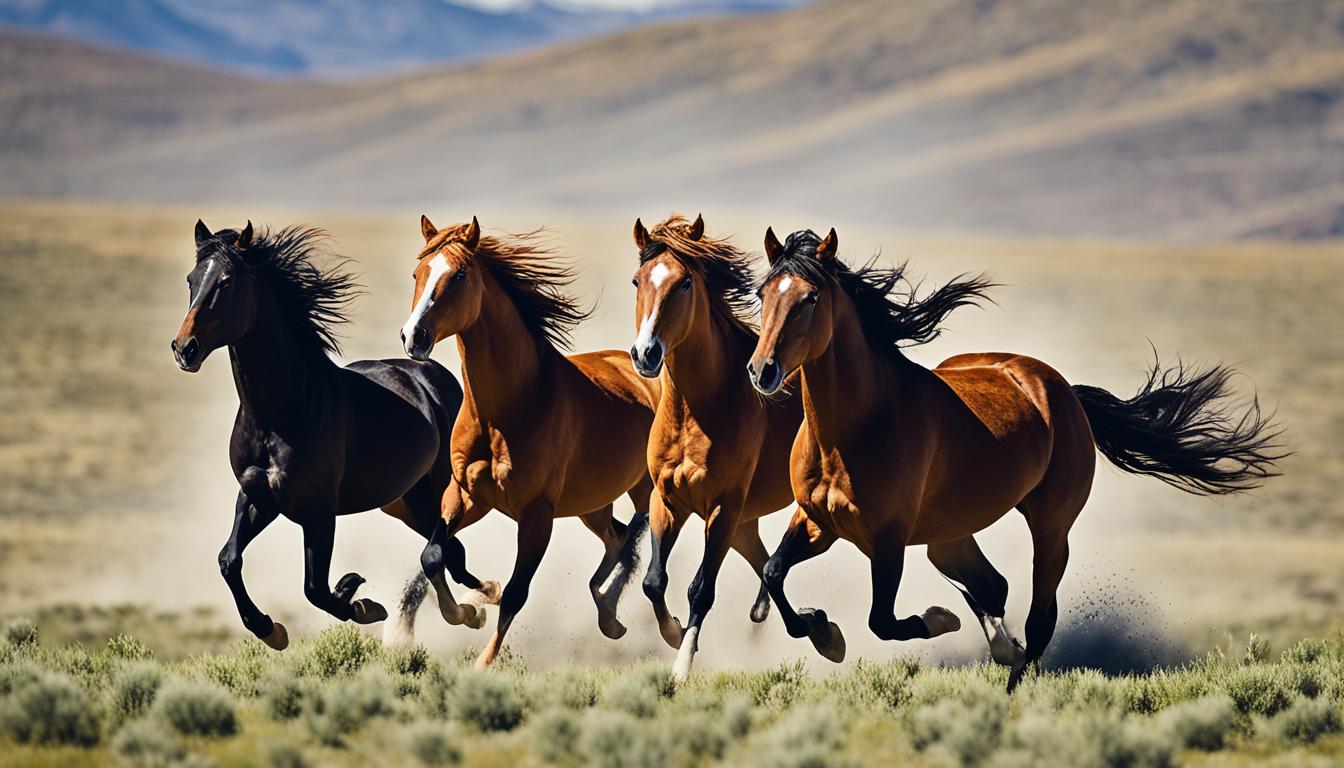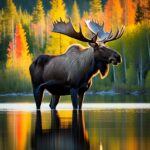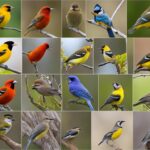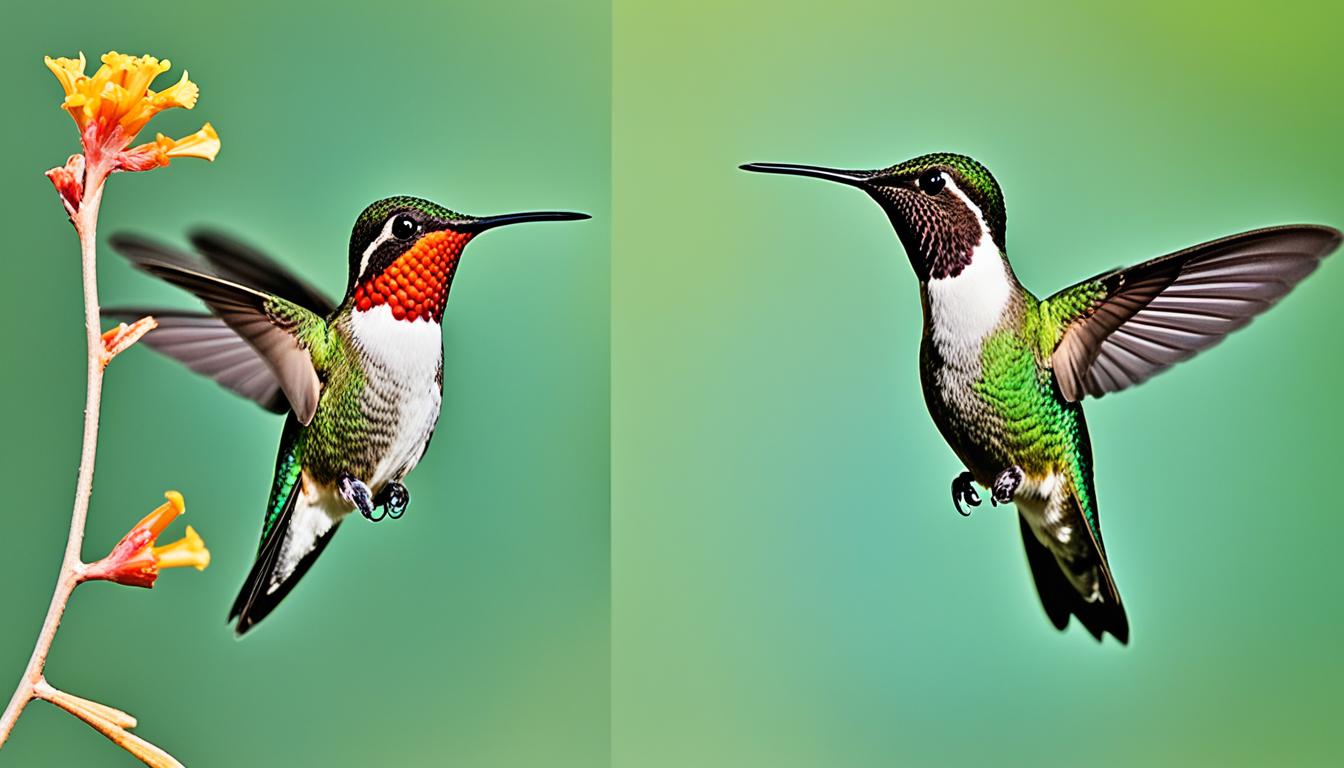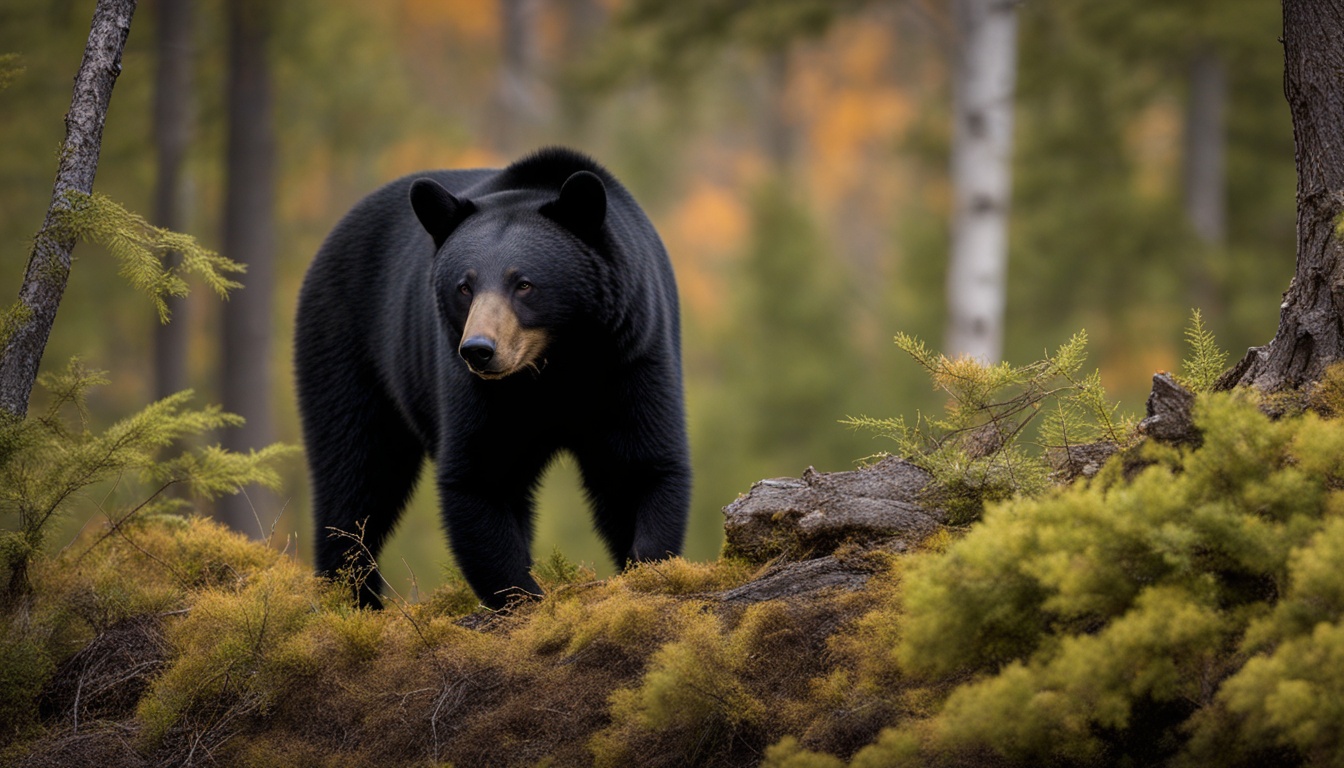The USA has wild mustangs that live in the western parts of the country. They mainly stay in designated areas across ten states. These horses are not recent arrivals. They were here long ago but went extinct in North America.
When the Spanish came, they brought horses back. This changed the lives of the Plains Indians a lot. Today, the mustangs aren’t taking up much space on the land compared to livestock.
Some people say there are too many mustangs. But, they aren’t growing in number very fast. The government plays a big part in how many mustangs there are.
Mustangs are a powerful symbol of America. They represent freedom and the American way of life. Yet, they have to deal with how the land is used and the effects on their homes.
The History of Wild Mustangs in America
America’s wild mustangs have an amazing history. They’ve shown great strength and change over time. Their story starts 50 million years ago with a small creature named Eohippus. This animal had many toes and later evolved into today’s horses.
The Evolution of Wild Mustangs
Mustangs and their story are all about staying alive. In the past, North America had many types of horses. However, they nearly disappeared 11,000 to 13,000 years ago. This was because of changes in the climate and humans hunting them too much.
The Role of the Spanish in Reintroduction
In the 16th century, the Spanish changed the American West by bringing horses. Some of these horses got away and started living wild. This moment is when wild mustangs, as we know them, began. They quickly spread across the land.
Impact of the Wild Free-Roaming Horses and Burros Act
By the 20th century, wild mustangs became fewer in number because of how they were treated. In the 1970s, there were only about 17,000 left. Thanks to people like “Wild Horse Annie,” the Wild Free-Roaming Horses and Burros Act was passed in 1971. This law protected these animals that are a big part of the West. But, there are still many questions about how to best take care of them.
Current Population and Distribution
Fact is, most wild mustangs live in ten states in the West. Each state has special places for them to roam. These spots help keep a balance between nature and where people live.
States with Wild Mustang Populations
Wild mustangs can be found on all kinds of land in these states:
- Nevada
- Wyoming
- California
- Montana
- Oregon
- Colorado
- Idaho
- Utah
- North Dakota
- Arizona
Current Population Estimates
Recent studies say there are about 86,000 wild mustangs today. They live on 28 million acres of public land. This is a big win for efforts to save them.
But, it shows we still need to work hard to protect their future. We must find ways to manage their numbers well.
| State | Approximate Mustang Numbers |
|---|---|
| Nevada | 44,000 |
| Wyoming | 6,000 |
| California | 5,000 |
| Montana | 500 |
| Oregon | 4,000 |
| Colorado | 3,000 |
| Idaho | 500 |
| Utah | 5,000 |
| North Dakota | 200 |
| Arizona | 1,500 |
Are there wild mustangs in the USA?
The Bureau of Land Management (BLM) oversees the care of wild mustangs across the U.S. Their job is to make sure these iconic horses survive while keeping the environment in order. They play a big role in balancing the ecosystem while looking after these animals.
BLM’s Role in Population Management
The BLM follows strict national policies when managing wild mustang populations. They keep an eye on how many horses are in each group, control the use of land, and work on policies to stop their numbers from growing too much.
The Impact of Roundups and Captivity
Horse roundups can be very stressful for the mustangs, and they disrupt their social life. These events are to control the population, leading some horses to live in captivity. This has caused debates over whether it’s right for the horses and our environment.
Herd Management Areas (HMAs)
The Bureau of Land Management (BLM) looks after Herd Management Areas (HMAs) in the American West. Their goal is to protect and manage wild horse herds. These areas have different landscapes but all are crucial for the horses’ survival and keep the environment healthy.
Locations of Major HMAs
Most mustangs live in big HMA areas in states like Nevada, Utah, and Wyoming. These places have wide, varied landscapes perfect for these wild horses.
| State | Major HMA Locations |
|---|---|
| Nevada | Antelope Complex, Pancake Complex |
| Utah | Confusion HMA, Sulphur HMA |
| Wyoming | Adobe Town HMA, Great Divide Basin HMA |
These places are not just spaces for mustangs. They show us the importance of balancing the land for different uses. The dry deserts in Nevada, Utah’s mountains, and Wyoming’s large plains have their own challenges. They also provide chances to keep the wild horse numbers up.
Challenges Facing Wild Mustangs
Wild mustangs face many challenges that put their future at risk. Human development is taking over their land, leading to habitat loss. Losing these areas makes it hard for the horses to find food and survive.
They also must compete with livestock for food and space. Grazing livestock can use up the resources the wild horses need. This situation causes problems for both the horses and the other animals.
Trying to manage the wild horse population has its downsides. Roundups and moving horses around can disrupt their social groups. This disruption causes stress and changes in the way they act, which is not good for their health.
| Challenges | Impact on Mustangs |
|---|---|
| Habitat Loss | Reduced roaming areas and access to food/water sources |
| Competition with Livestock | Depletion of essential resources |
| Disrupted Social Structures | Stress and behavioral changes in herds |
Conservation groups are working hard to help these horses. The best way to protect wild mustangs is by using smart conservation and land practices together. It’s essential for their survival.
Are Wild Mustangs Overpopulating?
The talk about too many wild mustangs is filled with differing views and proof. It’s crucial to look at both sides fairly. This helps us untangle the myth of wild mustang overpopulation.
Myth vs. Reality
Many worry about the land’s health due to the wild mustang overpopulation myth. But, studies and numbers show their herds are not growing too fast. The idea of too many mustangs is often from how we manage their environment, not from nature itself.
Impact of Livestock Grazing
Domestic animals, like cows, can harm the land even more than wild horses. They eat a lot of the grass, which makes the environment harsher for all animals. This can make it seem like there are too many mustangs, when there are other big issues at play.
Natural Predators and Their Role
Predators such as mountain lions usually help keep the horse numbers in check. Yet, efforts to protect livestock have made it harder for them to do their job. When we get rid of predators, we mess up the natural balance. This adds another layer of difficulty to managing the ecosystem.
Conservation Efforts and Their Effectiveness
Preserving wild mustangs involves many approaches to ensure their numbers are kept in check. This is vital for their existence and as symbols of America’s past. One key strategy is using birth control to avoid overcrowding. This has proven to be a kind and working way to help these animals.
Fertility Control Programs
Essential to saving mustangs is the PZP vaccine. It slows down their birth rates but keeps their lives natural.
Many who care about these animals support PZP. It’s user-friendly, safe, and doesn’t harm their freedom. These points show PZP is a good pick for keeping herds healthy.
| Program | Method | Effectiveness |
|---|---|---|
| PZP Vaccine | Immunocontraception | 90% successful in herd stabilization |
| GonaCon Vaccine | GnRH-based immunocontraception | 85% effective in reducing fertility |
| Surgical Sterilization | Permanent sterilization | 100% effective but invasive |
Using PZP and other vaccines is a way to let mustangs be while keeping them safe. It avoids the need for actions that can upset people, like large roundups. Thanks to these methods, we can protect mustangs and the environment they live in.
The Role of Advocacy Groups
Advocacy groups play a key role in protecting American mustangs. They act as connections between government, scientists, and the public. Their work ensures the preservation of mustangs through policy changes, awareness raising, and conservation support.
These groups go beyond advocacy. They help create and enforce strategies that keep the land and horses safe. This involves a lot of research, educating the public, and pushing for new laws.
One important thing these groups do is fight in court for mustangs. They make sure that laws protecting the mustangs’ homes and well-being are followed. This includes making sure the right practices are used when managing the mustang population.
They also run volunteer and community programs. These help people understand the mustangs’ challenges better. They also get more people involved in protecting the mustangs and their homes.
- Raising public awareness through campaigns and education
- Lobbying for protective legislation and humane management practices
- Conducting and supporting scientific research on equine conservation
- Facilitating community engagement and volunteer programs
Here is a table showcasing some key advocacy groups and their notable efforts:
| Advocacy Group | Notable Efforts |
|---|---|
| American Wild Horse Campaign | Advocating for policy reforms and humane management |
| The Cloud Foundation | Supporting educational initiatives and legal advocacy |
| Return to Freedom | Promoting sanctuary programs and public awareness |
Finally, these groups’ hard work is a big help in managing and conserving America’s wild mustangs. They ensure these symbols of freedom can keep living in the wild.
Understanding the Natural Behavior of Mustangs
Wild mustangs show unique characteristics because they live without human care. This makes them different from domesticated horses. Studying these traits helps us understand how they survive and work together.
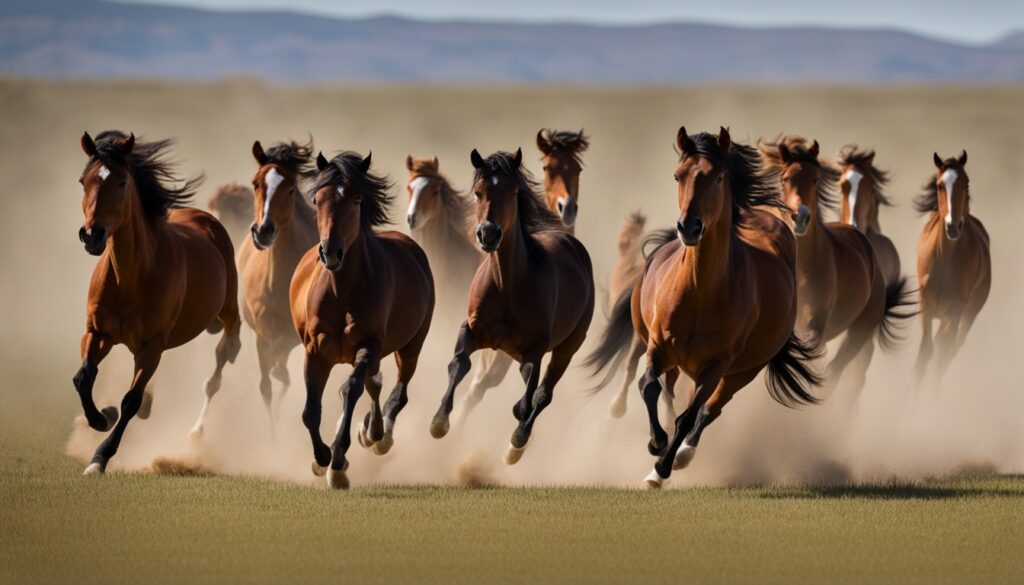
Differences Between Wild and Domestic Horses
Wild mustangs are highly adaptable to tough conditions, more than domestic horses. They use their instincts and work with others to overcome challenges. In contrast, domestic horses often look to people for help. Recognizing these distinctions is key to the domestic vs wild horses debate.
Social Structure of Mustang Herds
Mustangs have complex and clear social structures. They organize into bands, each with a lead stallion, several mares, and young horses. This setup offers safety and group stability. By examining these living arrangements, we learn how mustangs keep a balance, defend their areas, and care for their offspring.
The Cultural Significance of Wild Mustangs
Mustangs hold great cultural value in America’s past. They’re more than just creatures. They represent freedom and the will to survive.
They remind us of the people who explored the American West first. These horses symbolize the early challenges and victories of the land’s settlers.
Today, Americans see mustangs as proud emblems and feel inspired by their journey. Their tale of overcoming adversity touches our hearts, adding to our story of never giving up and being free. This cultural impact lives on, influencing those who paint, write, or fight for the horses’ rights.
Where to See Wild Mustangs in the United States
Seeing wild mustangs in the U.S. is a unique adventure. These majestic horses live in the wild in the western states. They can be seen in special areas called Herd Management Areas (HMAs). Knowing where to look and how to watch them without harming them makes the experience better.
Popular Locations for Mustang Viewing
The Onaqui Mountains in Utah are known for their beautiful scenery and lively mustang herds. Nevada’s Virginia Range and Montana’s Pryor Mountains are also great spots to see them. These areas are managed carefully to protect both the mustangs and the land. This makes them perfect places to enjoy nature and see mustangs up close.
Guided Tours and Tips for Viewing
If the western lands are new to you, think about a guided tour to see the mustangs. These tours are often led by experts. They share interesting facts about the mustangs and the places they live. It’s important to stay a safe distance from the horses. This keeps them from getting scared. Also, it’s key to follow the Leave No Trace principles to keep the environment safe. Viewing these incredible animals respectfully helps in keeping them around for the future.

